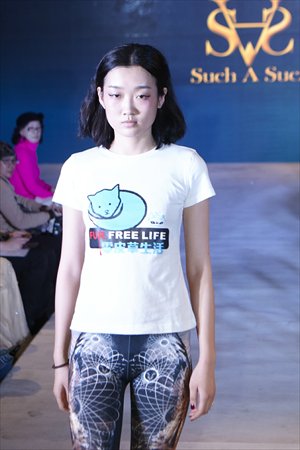HOME >> LIFE
Fur free fashion
Source:Global Times Published: 2015-1-23 5:03:02
ACTAsia calls for a life without cruelty to animals

A model walks the catwalk at the 2015 Cruelty Free Fashion Show in Beijing on Sunday. Photo: Courtesy of ACTAsia
Models wearing clothes designed with man-made fur or other eco-friendly and organic materials such as banana fibers, tree bark and recycled bottles walked the catwalk in Beijing on Sunday as part of the 2015 Cruelty Free Fashion Show.
Held by ACTAsia, a charity with branches in the UK, the Netherlands, China and the US, the event at the LEVI Art Studio featured 19 brands from six countries, and attracted numerous fashion designers and celebrities from both China and abroad.
"The Fur Free Fashion Show encourages the Chinese public, designers and retailers to make compassionate lifestyle choices and join a 'fur free life,'" Founder and Executive Director of ACTAsia Pei Su said at the event.
Explaining the charity's concept of a "fur free life," Su told the Global Times that their goal is to change people's idea that fur is a necessary element for luxury fashion.
"Most people still don't realize that animals are killed and factory farmed in brutal ways for the sake of a coat, and with all of the alternatives and innovations, wearing animals is not only cruel, it's outdated and unnecessary," Leanne Mai-ly Hilgart, the founder and chief designer of US-based VAUTE, was quoted as saying in a press release for the fashion show.
"I've dedicated my life to creating high tech and high design fashion that is good to the animals, workers and the environment, with innovative textiles using recycled and organic fibers," said Hilgart.
Actress Zhang Xinyu, Fan Chunxia and singer Shin received special star awards during the show for their contribution to promoting a fur free life. In a pre-recorded video sent to the event Zhang explained that she used to count several fur coats among her wardrobe, but decided not to purchase or use fur anymore. She also called for others to stop purchasing fur and turn to alternatives instead.
This is the second year ACTAsia has held the fur-free-themed fashion show.
"More brands have joined the Fur Free Alliance and pledged not to sell fur over the past year. We also carried out a lot of promotions aimed at students at colleges calling for them to pledge that they will not buy fur products. Many have kept their promise," Su told the Global Times.
Cruelty and necessity
Not only is China a major fur-producing country, it is also the world's biggest fur-consumer. According to a report released by chinaleather.org in December 2014, over 15 million martens, 3.4 million foxes and 3.5 million raccoons were raised for fur production in China in 2013.
"The industry has become gradually reviled in western countries, as they realize that the public dislike the harm the industry does to animals. In addition, the destruction the industry causes is a very high price to pay. Do we really need this type of polluting industry when the items it produces are not all that necessary for human beings?" Su told the Global Times.
The members of ACTAsia have visited several fur farms on many occasions. The fact that these animals are skinned alive aside, the conditions the well-lit conditions they live in are extremely unsuitable for these solitary notcurnal animals.
"We don't have any laws for animal welfare in China, so harmful and cruel conditions continue to exist. Someone who tortures animals is also the type of person that can be cold to human beings. So we believe that this problem for animals is also a problem for human beings," said Zhang Yue, a CCTV hostess and president of the Beijing Loving Animals Foundation.
"No one can blame ancient people for wearing fur, as it was necessary for them to defend against the cold. But nowadays, we have numerous other ways to achieve this function without killing animals. Cruelty beyond necessity is evil," Zhang added.
Changing industry
While the fur industry in China is still going strong, countries overseas have taken steps to change the situation. After banning fox and chinchilla farming, in December 2012 the Netherlands approved a law banning mink fur farming that will come into affect by 2024.
However, while animal lovers around the world were happy to hear the news, local fur farmers protested the law asking for 1 billion euros ($$1.1 billion) to make up for their financial losses.
The debate on fur issues have been raised more frequently than before across the globe over the past several years. An exhibition Fur: An Issue of Life and Death is currently being held at the National Museum of Denmark through February 22. Attempting to remain neutral, the exhibition covers the history of the industry's development while also introducing some of the earliest examples of "animal-free" fur. By providing information, the curators hope to leave the question to go "fur free" or not up to visitors.
Posted in: Fashion